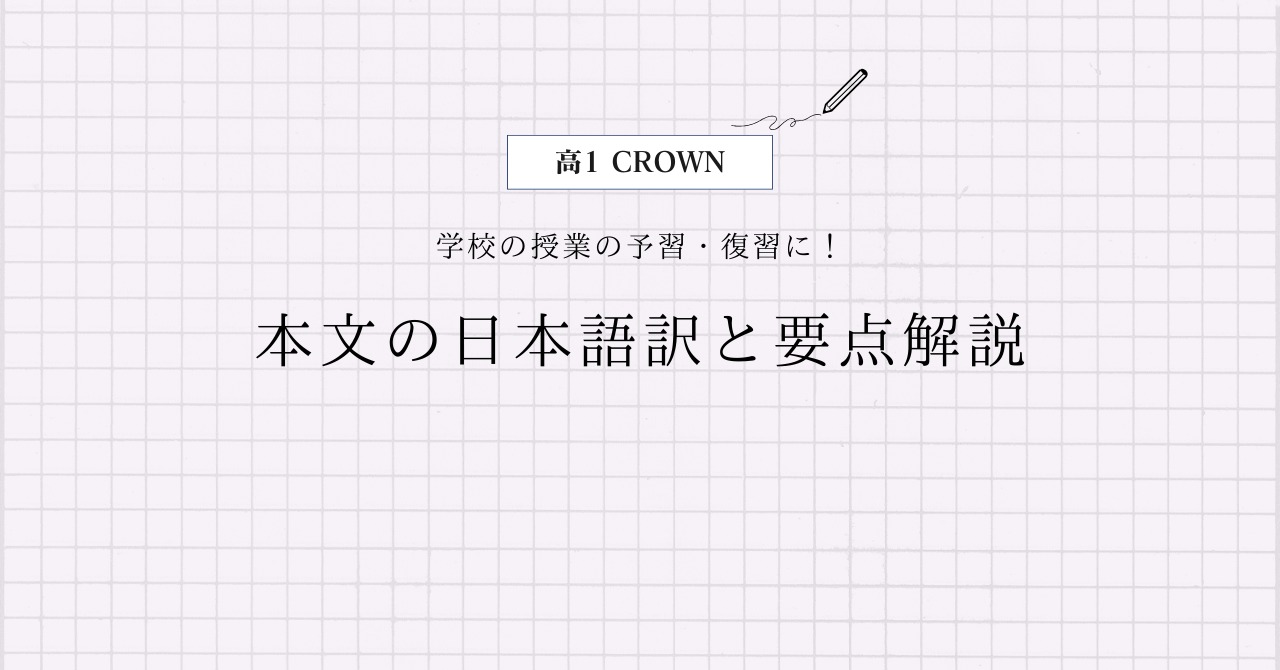三省堂 高1CROWN English Communication1 Lesson8 Section2の本文の日本語訳と重要箇所の解説です。
Section8-1, 8-3, 8-4の解説はこちらからご覧ください。
>高1CROWN English Communication1 Lesson8 Section1 本文和訳
>高1CROWN English Communication1 Lesson8 Section3 本文和訳
>高1CROWN English Communication1 Lesson8 Section4 本文和訳
- CROWN English Communication1 Lesson8 Section2 本文と日本語訳
- CROWN English Communication1 Lesson8 Section2 重要事項の解説
- This photograph was taken by an American photojournalist, Joe O’Donnell, in Nagasaki in 1945.
- He spoke to a Japanese interviewer about this picture:
- “I saw a boy about 10 years old walking by.
- He was carrying a baby on his back.
- In those days in Japan, we often saw children playing with their little brothers or sisters on their backs, but this boy was clearly different.
- I could see that he had come to this place for a serious reason.
- He was wearing no shoes. His face was hard.
- The little head was tipped back as if the baby were fast asleep.
- “The boy stood there for 5 or 10 minutes.
- The men in white masks walked over to him and quietly began to take off the rope that was holding the baby.
- That is when I saw that the baby was already dead.
- The men held the body by the hands and feet and placed it on the fire.
- “The boy stood there straight without moving, watching the flames.
- He was biting his lower lip so hard that it shone with blood.
- The flame burned low like the sun going down.
- The boy turned around and walked silently away.”
- Years later, O’Donnell said:
- “Children and their mothers did not deserve to die to win a war.”
- CROWN English Communication1 Lesson8 Section2 まとめ
CROWN English Communication1 Lesson8 Section2 本文と日本語訳
This photograph was taken by an American photojournalist, Joe O’Donnell, in Nagasaki in 1945.
「この写真は1945年に長崎で、アメリカ人写真記者のジョー・オダネルに撮られました。」
He spoke to a Japanese interviewer about this picture:
「彼はこの写真について、日本人のインタビュアーに話しました。」
“I saw a boy about 10 years old walking by.
『私は10歳くらいの少年が通り過ぎていくのを見ました。』
He was carrying a baby on his back.
『彼は赤ちゃんをおんぶしていました。』
In those days in Japan, we often saw children playing with their little brothers or sisters on their backs, but this boy was clearly different.
『当時の日本では、私たちは弟や妹を背負ったまま遊んでいる子どもたちをよく見ましたが、この少年は明らかに違いました。』
I could see that he had come to this place for a serious reason.
『彼は重大な理由でこの場所に来ていたのだと分かりました。』
He was wearing no shoes. His face was hard.
『彼は靴を履いていませんでした。彼の顔は険しかったです。』
The little head was tipped back as if the baby were fast asleep.
『赤ちゃんはまるでぐっすり眠っているかのように、小さな頭を後ろに倒していました。』
“The boy stood there for 5 or 10 minutes.
『その少年はそこに5分から10分間立っていました。』
The men in white masks walked over to him and quietly began to take off the rope that was holding the baby.
『白いマスクをした男性たちが彼のもとに歩いてきて、赤ちゃんを支えていたロープを静かに外し始めました。』
That is when I saw that the baby was already dead.
『それが、その赤ちゃんがすでに亡くなっていたのだと分かった時です。』
The men held the body by the hands and feet and placed it on the fire.
『男性たちは赤ちゃんの手と足を抱えて、火の中に入れました。』
“The boy stood there straight without moving, watching the flames.
『少年は炎を見ながら、動かずにまっすぐそこに立っていました。』
He was biting his lower lip so hard that it shone with blood.
『彼は下唇を噛みしめていたので、血で光っていました。』
The flame burned low like the sun going down.
『炎は太陽が沈むように薄暗く燃えていました。』
The boy turned around and walked silently away.”
『少年は振り返って、無言で立ち去りました。』
Years later, O’Donnell said:
「数年後、オドネルは言いました。」
“Children and their mothers did not deserve to die to win a war.”
『子どもたちと彼らの母親は、戦争に勝つためだからといって死ぬのはふさわしくなかったです。』

CROWN English Communication1 Lesson8 Section2 重要事項の解説
This photograph was taken by an American photojournalist, Joe O’Donnell, in Nagasaki in 1945.
この文は「受動態」が使われていますね。
“photograph”は「写真」という名詞ですね。“photo”は“photograph”の省略形です。
“American“は「アメリカ人の」という形容詞、“photojournalist“は「写真記者」という名詞です。
“an American photojournalist“と“Joe O’Donnell“は「同格語」になります。“名詞,名詞”の並びは「同格語」の可能性が高いですよ!
He spoke to a Japanese interviewer about this picture:
“speak to 人”は「に話しかける」という表現です。
“interviewer”は「インタビュアー、面接官」という名詞ですね。
「:」は「コロン」と言い,簡単に言うと「つまり」という具合に直前の文章を補足します。コロンを使うときは,コロンの前は必ず文にしないといけない点に注意してください。
“I saw a boy about 10 years old walking by.
“see”は「知覚動詞」で、“see 名詞 動詞のing形”で「名詞が~しているのを見る」となります。
“about”は「約、およそ」といった副詞で、“walk by”は「通りかかる」という表現です。
He was carrying a baby on his back.
この文は「過去進行形」になっていますね。
“carry”は「を運ぶ」という動詞で、“carry A on one’s back”で「Aを背負う、おんぶする」という意味になります。
“back”は「背中」という名詞です。
In those days in Japan, we often saw children playing with their little brothers or sisters on their backs, but this boy was clearly different.
“in those days”は「当時」という表現です。
“often”は「よく、しばしば」という副詞で、“playing”は「現在分詞」になります。
“playing with their little brothers or sisters on their backs”が“children”を修飾しています。
この“with”は「~のままで」くらいで訳すといいと思います。セットというイメージですね。
“brother”や“sister”の前に“little”をつけると「弟、妹」となります。
“clearly”は「明らかに」という副詞で、“different”は「違った、異なった」という形容詞です。
I could see that he had come to this place for a serious reason.
“I can see that~”で「~だと分かる」という意味になります。今回は“could”なので過去形ですね。
“had come”は「過去完了」になっています。
“place”は「場所」、“reason”は「理由」という名詞で、“serious”は「重大な、深刻な」といった形容詞になります。
He was wearing no shoes. His face was hard.
この文は「過去進行形」になっていますね。
“wear”は「を着る、身につける」という動詞で、“no”は「少しも~ない」という形容詞、“shoe”は「靴」という名詞です。
“face”は「顔」という名詞で、“hard”はここでは「険しい」という形容詞ですね。
The little head was tipped back as if the baby were fast asleep.
“little”は「小さな」という形容詞、“head”は「頭」という名詞ですね。
また、ここでは「受動態」になっています。
“tip back~”は「を後ろに傾ける」といった意味です。直訳すると「小さな頭は後ろに傾けられていた」となりますが、少し変な日本語になるので「小さな頭を後ろに傾けていた」と訳しています。
“as if 仮定法”は「まるで~かのように」という重要表現になります。「仮定法」なので、“were”になっていますね。
“fast asleep”は「ぐっすり眠って」といった表現です。
“The boy stood there for 5 or 10 minutes.
“stood”は“stand(立つ)”の過去形ですね。
“there”は「そこに」という副詞で、“for 時間”は「~間」という意味になります。
The men in white masks walked over to him and quietly began to take off the rope that was holding the baby.
“men”は“man(男の人)”の複数形ですね。
“in”は「~を身につけている」といった意味も持つ前置詞です。“mask”は「マスク」です。
“walk over to~”は「~のもとに歩いてくる」、“began”は“begin(を始める)”の過去形、“quietly”は「静かに」という副詞ですね。
“take off~”は「を外す、取り除く」という表現で、ここでは“to”があるので「不定詞の名詞的用法」になっています。
“rope”は「ロープ、縄」という名詞で、“that”は「目的格の関係代名詞」です。
“that was holding the baby”が先行詞“the rope”を修飾していますね。“hold”は「を掴む、支える」といった動詞になります。
That is when I saw that the baby was already dead.
“That is when~”は「それが~の時だ」という意味です。“when”は「関係副詞」ですね。
“that”は接続詞で、“already”は「すでに、もう」という副詞、“dead”は「死んでいる」という形容詞になります。
The men held the body by the hands and feet and placed it on the fire.
“held”は“hold”の過去形ですね。“hold A by B”で「AのBを掴む」といった意味になります。
“hand”は「手」、“feet”は“foot(足)”の複数形で、“place”は「を置く」という動詞です。
“it”は“the body”を指していて、“fire”は「火」という名詞ですね。
“The boy stood there straight without moving, watching the flames.
“straight”は「まっすぐに」という副詞、“without”は「~なしで」という前置詞になります。
“move”は「動く」という動詞で、前置詞の後ろなので「動名詞」になっていますね。
“watching”は直前にカンマがあるので「分詞構文」で、ここでは「~しながら」という「付帯状況」で訳してあげましょう。
“flame”は「炎」という名詞ですね。
He was biting his lower lip so hard that it shone with blood.
この文は「過去進行形」になっていますね。
“bite”は「を噛む」という動詞で、“lower”は「下の」という形容詞、“lip”は「唇」という名詞、“hard”は「かたく」といった副詞です。
また、この文は「so that構文」になっているので、「とても~なのでthat以下…」と訳してあげましょう。
“it”は“his lower lip”を指していて、“shone”は“shine(輝く、光る)”の過去形です。
“shine with~”は「~で光る」という意味で、“blood”は「血」という名詞ですね。
The flame burned low like the sun going down.
“burn”は「燃える」という動詞で、“low”は「低く、薄暗く」といった副詞です。
“like”は「~のように」という前置詞で、“sun”は「太陽」という名詞、“go down”は「下りる、沈む」という意味ですね。
“going down”は「動名詞」になっていて、“the sun”は「動名詞」の意味上の主語になっています。
つまり「太陽が沈むように~」という意味です。
The boy turned around and walked silently away.”
“turn around”は「振り返る、向きを変える」、“walk away”は「立ち去る」といった意味になります。
“silently”は「黙って、無言で」という副詞ですね。
Years later, O’Donnell said:
“later”は「後に、あとで」という副詞です。
“years later”で「数年後」ですね。
“Children and their mothers did not deserve to die to win a war.”
“deserve to~”は「~に値する、ふさわしい」という意味です。
“die”は「死ぬ」という動詞で、ここでは「不定詞の名詞的用法」に、“win”は「に勝つ」という動詞で、こちらは「不定詞の副詞的用法」になっていますね。
“war”は「戦争」という名詞です。
CROWN English Communication1 Lesson8 Section2 まとめ
以上がCROWN English Communication1 Lesson8 Section2の日本語訳となります。
「分詞構文」「関係副詞」「知覚動詞」などの使い方をしっかり確認しておきましょう!
>高1CROWN English Communication1 Lesson8 Section1 本文和訳
>高1CROWN English Communication1 Lesson8 Section3 本文和訳
>高1CROWN English Communication1 Lesson8 Section4 本文和訳
何か分からない点や他に解説してほしい点があれば,お気軽にコメントしてください!



コメント